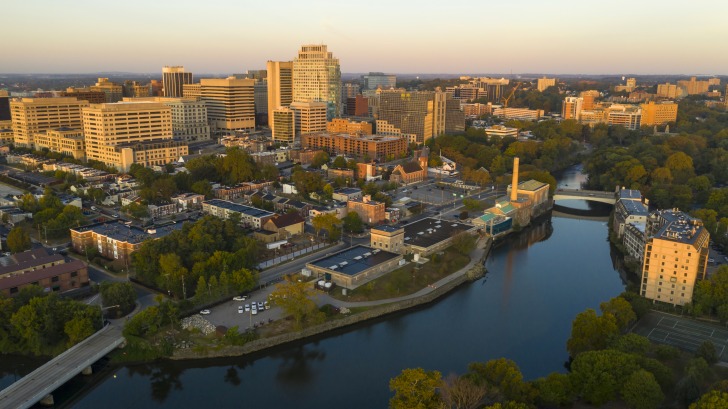Delaware, known as the First State, offers appealing qualities: beautiful beaches, rich history, tax-friendly policies, and proximity to major metropolitan areas. Yet, like most states, Delaware has areas that pose more challenges for those considering relocating there. This article aims to identify the top 5 worst places to live in Delaware, factoring in essential aspects that impact quality of life.
Factors Considered
This analysis goes beyond merely listing “bad” places. The following key elements have been carefully weighed when determining this list:
- Crime Rates: Safety is paramount. Statistics on violent crime (murder, assault, robbery) and property crime (theft, burglary) are vital indicators of an area’s livability.
- Cost of Living and Housing Affordability: Delaware’s cost of living can vary significantly. Areas with inflated housing prices, high taxes, and expensive everyday necessities present financial burdens.
- Employment Opportunities: A thriving job market with diverse employment options is essential for economic stability and resident well-being.
- Educational Quality: Excellent school systems are important, especially for families, as they significantly impact a child’s future opportunities.
- Amenities and Quality of Life: Access to parks, restaurants, entertainment options, and a sense of community contribute to overall satisfaction with a location.
5 Worst Places to Live in Delaware
1. Wilmington
- Crime: Wilmington consistently struggles with some of the highest crime rates in Delaware and the nation. Violent crime rates significantly exceed both state and national averages.
- Cost of Living: While certain areas of Wilmington offer high-end living, many neighborhoods face inflated housing prices and above-average costs of living.
- Employment: The job market is mixed, with a concentration in specific industries making it difficult for those with specialized skills to find positions.
- Education: The city’s school system faces challenges with underperforming schools and higher dropout rates.
- Amenities: While Wilmington boasts historical sites and cultural attractions, a sense of blight and limited recreational activities persist in some sections.
2. Dover
- Crime: Dover, the state capital, has property and violent crime rates exceeding Delaware’s averages.
- Cost of Living: Housing costs have risen in recent years, presenting affordability challenges for residents.
- Employment: Employment opportunities are primarily centered around government jobs, leading to limitations for those seeking a wider range of fields.
- Education: While there are some well-regarded schools, the Dover school district contends with inconsistent performance.
- Amenities: The city lacks the vibrancy of a major metropolitan area, with limited dining and entertainment options.
3. Seaford
- Crime: Seaford battles property crime rates well above the state average, making residents susceptible to thefts and burglaries.
- Cost of Living: While more affordable than some Delaware cities, Seaford residents face rising costs for essentials like groceries and utilities.
- Employment: Job opportunities are primarily found in fields like agriculture and manufacturing, making it less attractive to those seeking professional careers.
- Education: School performance in the Seaford School District is generally below state averages.
- Amenities: The city offers basic necessities but lacks a diverse array of shopping, dining, or cultural attractions.
4. Laurel
- Crime: Laurel contends with higher-than-average violent and property crime rates within the state.
- Cost of Living: Affordability can be deceiving in Laurel, as lower housing costs are sometimes offset by higher expenses in other areas.
- Employment: The job market is heavily reliant on the poultry industry, offering limited options for workers.
- Education: School test scores in Laurel commonly fall below the state average, impacting children’s potential for future success.
- Amenities: The city has a small-town feel, with fewer recreational opportunities and a sense of stagnation in its development.
5. Milford
- Crime: Milford grapples with both violent and property crime exceeding Delaware’s averages.
- Cost of Living: Housing growth in Milford has brought rising prices, straining affordability for its residents.
- Employment: While offering some job opportunities, Milford’s economy is not particularly robust or diverse.
- Education: The Milford School District has room for improvement, with average school performance results.
- Amenities: Basic amenities are present in Milford, but residents may seek more diverse entertainment and cultural options elsewhere.
Important Considerations
It’s crucial to note that such rankings involve a degree of subjectivity. What’s considered a negative factor by one person could be less important to another. Additionally, these statistics fluctuate over time. Areas may experience improvement or further decline, making it vital for potential residents to always conduct their own up-to-date research. Visiting a place in person offers irreplaceable insight into the atmosphere of a city.
Conclusion
This article aims not to disparage Delaware entirely, but to provide a candid starting point for those considering a move to the state. It highlights areas where potential residents might face real challenges, encouraging them to conduct thorough research with their individual priorities in mind. By carefully weighing the factors that matter most, individuals can make well-informed decisions about where to call home within Delaware.



